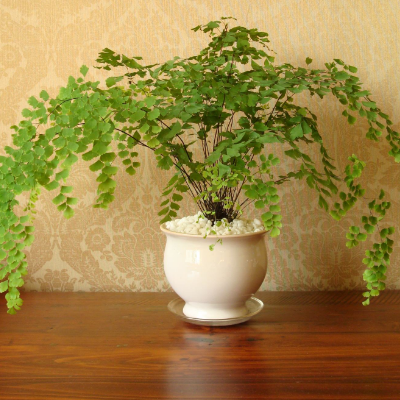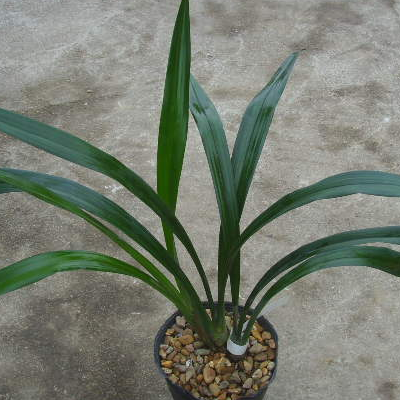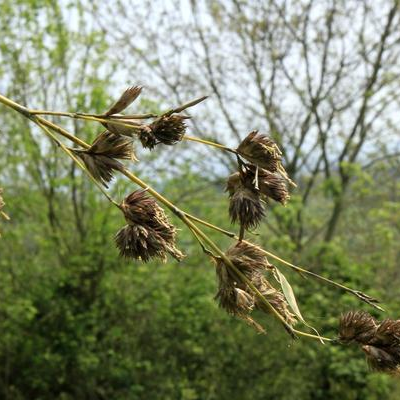Is the fern poisonous? what if the leaves turn yellow?
Dryopteris is a good plant to purify the air, and it can also be used as a potted plant, so is it poisonous? What if the leaves of Dryopteris fern turn yellow?

Is Dryopteris acuminata poisonous?
Dryopteris is not poisonous. Clematis, also known as clematis, girl's hair, clematis, water pig hair soil, etc., taste light, bitter, cool, non-toxic, with the effects of heat-clearing and detoxification, dampness and detumescence, diuresis and catharsis, often used for dysentery, dysentery, lung heat cough, hepatitis, gonorrhea syndrome, snake bite, fall injury and other diseases.
What if the leaves of Dryopteris fern turn yellow:
1. Yellowing of leaves caused by excessive light
[cause of yellowing] Dryopteris is a shade plant. If the strong sunlight is in direct sunlight, it can easily cause the leaf margin to scorch and the leaves to turn yellow.
[solution] it is necessary to pay attention to shade in outdoor training, but it is also necessary to provide sufficient sunlight to grow. Indoors, it is best to keep the flowerpot on the east or north windowsill of the room.
2. Yellowing of leaves caused by insufficient watering
[causes of yellowing] during the growth of Dryopteris, it is necessary to fully water and maintain high air humidity to keep the leaves dark green. If the water supply is insufficient or the air is dry, the leaves will turn yellow or curl scorched.
[solution] it is necessary to spray water on the branches and leaves for 2 or 3 times a day in the peak growing season.
3. Yellowing of leaves caused by improper fertilization
[cause of yellowing] improper watering and fertilization of Dryopteris will stain the leaf surface, resulting in withered and yellow leaves and affect the ornamental effect.
[solution] the amount of fertilizer needed for Dryopteris is not much, generally applying thin pancake fertilizer and water every 2-3 weeks, and the effect is better if a small amount of calcareous fertilizer can be added.
4. Yellowing of leaves caused by soil discomfort
[cause of yellowing] Dryopteris grows fast and needs to be changed every spring. Dryopteris prefers loose, permeable and fertile calcareous sandy loam, and attention should be paid to the choice of soil if the soil does not conform to the growth habits of Dryopteris. It is easy to lead to poor growth of Dryopteris, and the leaves begin to yellowing and falling.
[solution] the cultivated soil in pot can be mixed with loam, rotten leaf soil and river sand in the same amount.
5. Yellowing of leaves caused by improper pruning
[cause of yellowing] Dryopteris should be cut off in time when withered leaves are found in the maintenance process, so as to keep the plant fresh and beautiful, and conducive to the germination of new leaves, otherwise the branches and leaves will be too cluttered and crowded, the growth will be weak and the leaves will turn yellow.
[solution] when the leaves of Dryopteris are too dense, the old leaves can be pruned properly every autumn.
All right, you guys all know, it's not poisonous.
Is Dryopteris virulent? the species of Dryopteris
Dryopteris is a perennial herb of the genus Dryopteris of the family Pteridaceae, which has high ornamental and medicinal value, strong adaptability, easy cultivation and suitable for indoor perennial potted plants. it is one of the most popular potted foliage plants in the house. let's take a look at whether the fern is poisonous.
Is Dryopteris fern poisonous?
Dryopteris is not poisonous. Clematis, also known as clematis, girl's hair, clematis, water pig hair soil, etc., taste light, bitter, cool, non-toxic, with the effects of heat-clearing and detoxification, dampness and detumescence, diuresis and catharsis, often used for dysentery, dysentery, lung heat cough, hepatitis, gonorrhea syndrome, snake bite, fall injury and other diseases.
Species of Dryopteris Dryopteris
1. Dryopteris: Dryopteris plants 20-45 cm tall, rhizomes short and erect, densely covered with brown, glossy subulate-lanceolate scales, leaves clustered, leaves bifurcated, leaves nearly leathery after stem, green or often brown, both sides glabrous, sporangium 2-5 per pinna, transversely on the upper and outer margin of lobes, separated by notch, the cyst cover is semicircular or oblong, the upper margin is straight, leathery. Brown-black, entire, persistent, spores with inconspicuous granular ornamentation.
2. Dryopteris flagellata: Dryopteris Dryopteris, also known as Dryopteris Dryopteris, leaves linear-lanceolate, about 10-25 cm long, the tip is often extended into a whip-shaped, landing root, leaf sword oblong, one-pinnate or two-tearing, the upper and outer margin is often deeply divided into narrow lobes, the lower margin is straight and entire, the sporangium group is born under the capsule cover which is metamorphosed and reflexed from the top of the lobes, the cyst cover kidney-shaped to round-shaped, slightly hairy.
3. Dryopteris: Dryopteris, also known as Dryopteris przewalskii, Dryopteris, etc., is 5-20 cm high, the rhizome is short and erect, the leaf is elliptic kidney-shaped, 2-6 cm wide, the top is dark green, smooth and has 1-3 identical rings, the lower part is sparsely brown villous, the leaf margin is circular-serrated, and the leaf edge of the long spore is rolled back into a pseudocyst cover. The sporangium group is oblong or short linear, born on the leaf margin.
How to raise Dryopteris
1. Soil: Dryopteris likes loose, permeable and fertile calcareous sandy loam. when potted, the cultivated soil can be mixed with loam, rotten leaf soil and river sand.
2. Temperature: Dryopteris likes to be warm, and the suitable temperature for environmental growth is 13-22 ℃. It is excellent to plant in spring in the south, and it is also possible in the north, but because Dryopteris is not resistant to high temperature, the maintenance methods are also different.
3. Lighting: the fern likes the semi-shady environment. Do not let the fern shine directly in the sun. It is suitable to grow in the semi-shade.
4. Watering: clematis like to be moist and should be watered more during the growing period. when the weather is hot, the leaves should be sprayed or watered to maintain high air humidity and clear leaf patterns and emerald green leaves.
5. Fertilization: apply thin liquid fertilizer 2-3 times a month, do not stain the leaf surface when applying fertilizer, so as not to cause rotten leaves. Because of the calcium-loving habit of Dryopteris, basin soil should add appropriate amount of lime and broken eggshell, and the effect of often applying calcareous fertilizer will be better. It is necessary to reduce watering in winter and stop fertilizing.
6. Insect pests: potted Dryopteris, often with leaf blight, can be controlled with Bordeaux liquid at the initial stage, 1000-1500 times solution of methyl topiramate can be used to control severe cases, and 1000 times solution of omethoate can be used to control plants damaged by scale insects.
7. Pruning: after autumn, as the temperature drops, Dryopteris will grow slowly, and the old leaves will gradually turn yellow, so cut them off.
To sum up, Dryopteris is not poisonous! I hope this article will be helpful to you to cultivate Dryopteris.
Is the fern poisonous? what are the species of Dryopteris?
Dryopteris Dryopteris is a perennial herb of the genus Adimaceae, which has high ornamental and medicinal value, strong adaptability and easy cultivation, so is it poisonous? What are the species of Dryopteris?
Is Dryopteris fern poisonous?
Dryopteris is not poisonous. Clematis, also known as clematis, girl's hair, clematis, water pig hair soil, etc., taste light, bitter, cool, non-toxic, with the effects of heat-clearing and detoxification, dampness and detumescence, diuresis and catharsis, often used for dysentery, dysentery, lung heat cough, hepatitis, gonorrhea syndrome, snake bite, fall injury and other diseases.
Species of Dryopteris Dryopteris
1. Dryopteris: Dryopteris plants 20-45 cm tall, rhizomes short and erect, densely covered with brown, glossy subulate-lanceolate scales, leaves clustered, leaves bifurcated, leaves nearly leathery after stem, green or often brown, both sides glabrous, sporangium 2-5 per pinna, transversely on the upper and outer margin of lobes, separated by notch, the cyst cover is semicircular or oblong, the upper margin is straight, leathery. Brown-black, entire, persistent, spores with inconspicuous granular ornamentation.
2. Dryopteris flagellata: Dryopteris Dryopteris, also known as Dryopteris Dryopteris, leaves linear-lanceolate, about 10-25 cm long, the tip is often extended into a whip-shaped, landing root, leaf sword oblong, one-pinnate or two-tearing, the upper and outer margin is often deeply divided into narrow lobes, the lower margin is straight and entire, the sporangium group is born under the capsule cover which is metamorphosed and reflexed from the top of the lobes, the cyst cover kidney-shaped to round-shaped, slightly hairy.
3. Dryopteris: Dryopteris, also known as Dryopteris przewalskii, Dryopteris, etc., is 5-20 cm high, the rhizome is short and erect, the leaf is elliptic kidney-shaped, 2-6 cm wide, the top is dark green, smooth and has 1-3 identical rings, the lower part is sparsely brown villous, the leaf margin is circular-serrated, and the leaf edge of the long spore is rolled back into a pseudocyst cover. The sporangium group is oblong or short linear, born on the leaf margin.
How to raise Dryopteris
1. Soil: Dryopteris likes loose, permeable and fertile calcareous sandy loam. when potted, the cultivated soil can be mixed with loam, rotten leaf soil and river sand.
2. Temperature: Dryopteris likes to be warm, and the suitable temperature for environmental growth is 13-22 ℃. It is excellent to plant in spring in the south, and it is also possible in the north, but because Dryopteris is not resistant to high temperature, the maintenance methods are also different.
3. Lighting: the fern likes the semi-shady environment. Do not let the fern shine directly in the sun. It is suitable to grow in the semi-shade.
4. Watering: clematis like to be moist and should be watered more during the growing period. when the weather is hot, the leaves should be sprayed or watered to maintain high air humidity and clear leaf patterns and emerald green leaves.
5. Fertilization: apply thin liquid fertilizer 2-3 times a month, do not stain the leaf surface when applying fertilizer, so as not to cause rotten leaves. Because of the calcium-loving habit of Dryopteris, basin soil should add appropriate amount of lime and broken eggshell, and the effect of often applying calcareous fertilizer will be better. It is necessary to reduce watering in winter and stop fertilizing.
6. Insect pests: potted Dryopteris, often with leaf blight, can be controlled with Bordeaux liquid at the initial stage, 1000-1500 times solution of methyl topiramate can be used to control severe cases, and 1000 times solution of omethoate can be used to control plants damaged by scale insects.
7. Pruning: after autumn, as the temperature drops, Dryopteris will grow slowly, and the old leaves will gradually turn yellow, so cut them off.
- Prev

How does Mulan grow up well? can it purify the air?
Mulan, this is a kind of plant, can be raised at home, generally can be used as a potted plant, how to grow well? Can Melan purify the air: how to raise and grow well: (1) Seedling. ① ramet propagation: from the root of Cymbidium during the dormant period
- Next

Why does the bamboo die after it blossoms? is there any sign?
Bamboo, this is seen by many people, if in the countryside, it is super common, why does this bamboo die after blooming? Is there any sign of bamboo blooming: why bamboo dies after flowering: this is a question that people have been puzzled for a long time, and scientists hold different views on it.
Related
- Fuxing push coffee new agricultural production and marketing class: lack of small-scale processing plants
- Jujube rice field leisure farm deep ploughing Yilan for five years to create a space for organic food and play
- Nongyu Farm-A trial of organic papaya for brave women with advanced technology
- Four points for attention in the prevention and control of diseases and insect pests of edible fungi
- How to add nutrient solution to Edible Fungi
- Is there any good way to control edible fungus mites?
- Open Inoculation Technology of Edible Fungi
- Is there any clever way to use fertilizer for edible fungus in winter?
- What agents are used to kill the pathogens of edible fungi in the mushroom shed?
- Rapid drying of Edible Fungi

